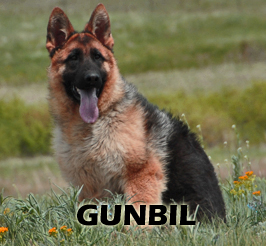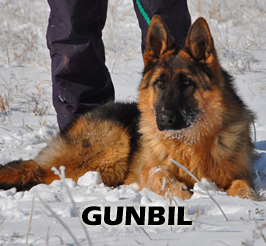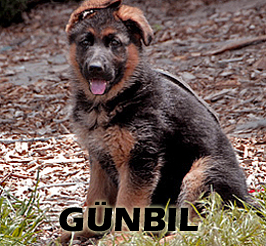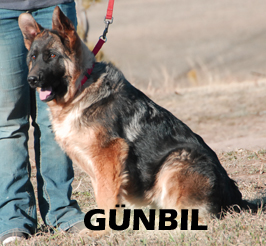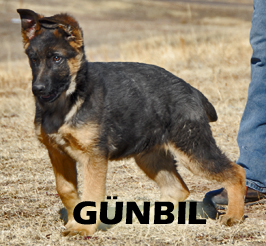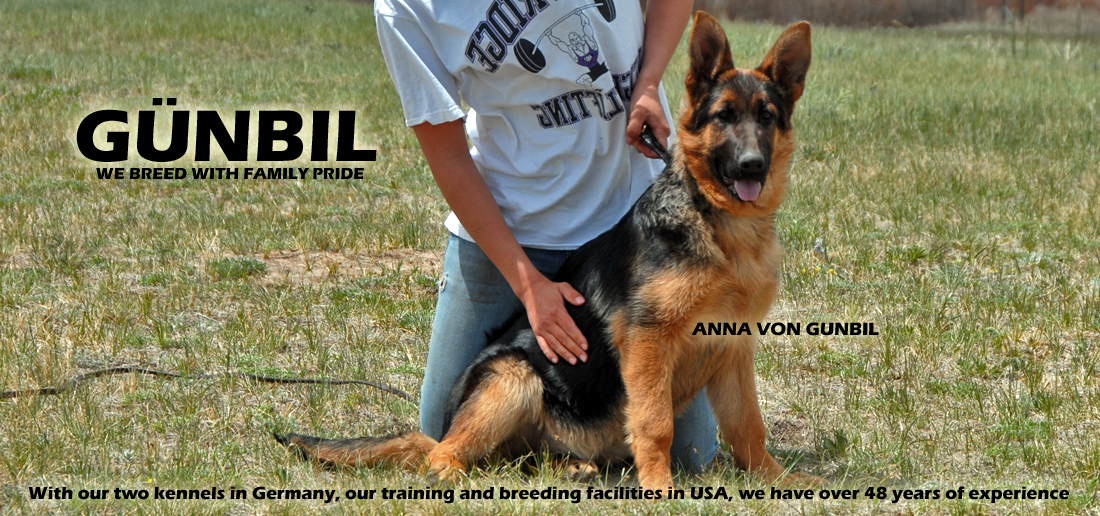
German shepherd breed standard - (FCI Standard Edition 1993)
Short Historical Overview:
- In accordance with the official provisions of the German Shepherd Dog Club (SV) e.V., located in Augsburg, a member of the Federation of Dog Clubs in Germany (VDH) is the founding organization of the German Shepherd Dog and therefore, responsible for the breed standard.
- Work on this document was begun at the first membership meeting in Frankfurt/M on September 20, 1899 and is based on proposals by A. Meyer and v. Stephanitz.
Additions and revisions to the standard were made as follows:
- Membership meeting on July 28, 1901
- 23rd membership meeting on September 17, 1909 in Köln
- Board and Executive Committee Meeting on September 5, 1930 in Wiesbaden
- the Breeders Committee and Board Meeting on March 25, 1961 in conjunction with the WUSV (World Union of German Shepherd Clubs).
- WUSV Meeting on August 30, 1976 where the standard was agreed upon
- Revised, and approved by the Board and Executive Committee on March 23 and 24, 1991.
- Planned breeding activities began after the inception of the SV in 1899.
- The German Shepherd Dog was developed from herding dogs in service during that time in Middle and Southern Germany. The goal was to produce a high-performance working dog.
- To accomplish this goal, the Breed Standard of the German Shepherd Dog was created.
- This document addresses both physical qualities as well as character attributes.
General Appearance: The German Shepherd Dog is medium sized, slightly longer than tall, strong and well muscled, bone is dry, the whole dog presenting a picture of firmness.
Important Measurements: Height at the withers for males: 60 - 65 cm, bitches: 55 - 60 cm. Length of torso exceeds height at the withers by 10 - 17%.
Character: The German Shepherd should appear poised, calm, self confident, absolutely at ease, and (except when agitated) good natured, but also attentive and willing to serve. He must have courage, fighting drive, and hardness in order to serve as companion, watchdog, protection dog, service dog, and herding dog.
Head: The head is wedge-shaped and in harmony with the dog’s size (length app. 40% of height at the withers) without being coarse or overly long. The head should appear dry, and moderately wide between the ears. Seen from the front and side, the forehead is only slightly domed, the center furrow is either absent or only slightly visible. The length ratio of skull to face is 50 : 50%. Skull width approximately equals skull length. Seen from above, the skull slopes into a wedge-shaped muzzle. The stop should not be pronounced. Upper and lower jaws are strong, the bridge of the nose should be straight, not a Roman nose or dish-faced nose. Lips are taut, well closed and of dark color.
The Nose: The nose should be black
Teeth: The teeth must be strong and complete in number (42 teeth as per formula). The German Shepherd has a scissor bite, where the upper incisors must meet the lower incisors in a scissor grip. Level bite, overshot and undershot teeth are faulty, as well as widely-spaced teeth. A straight incisor tooth line is also faulty. Jawbones must be well developed, to permit deep rooting of the teeth in the gum.
The Eyes: The eyes are medium sized, almond-shaped, set slightly oblique and not protruding. The color should be as dark as possible.
The Ears: The German Shepherd has medium-sized, upright ears which are carried erect and perpendicular to one another, pointed and open to the front. Tipped ears and hanging ears are faulty. Laid-back ears are not faulty when the dog is in motion or resting.
Neck: The neck is strong, well-muscled, and clean cut (without folds of loose skin). The angle of neck to torso is approximately 45 degrees.
Body: The top line extends from the point where the neck meets the skull past the well developed withers and the gently downward sloping back to the slightly sloping croup without a visible break. The back is firm, strong, and well muscled. The loin is broad, well developed, and strongly muscled. The croup should be long and have a slight downward slope (approximately 23 degrees from horizontal) and should merge smoothly into the tail set.
Chest: The chest should be of moderate width, the under chest long and pronounced. Chest depth should be approximately 45 to 48% of height at the withers. The ribs should be moderately sprung. Barrel shaped or flat ribs are faulty.
Tail: The tail reaches at least to the hock joint, but not past the halfway point of the hock itself. The coat is slightly longer on the underside of the tail. The tail hangs in a soft, saber-like curve. When the dog is excited or in motion, the tail is somewhat raised, but should not reach past the horizontal line. Surgical corrections are not permitted.
Limbs/Forelegs:
- Seen from all sides, the forelegs are straight and absolutely parallel when viewed from the front.
- Shoulder and upper arms are of equal length. Both are held snugly to the body by strong muscles. Angulation of shoulder blade to the upper arm ideally is 90 degrees, but up to 110 degrees is permissible.
- Elbows may not turn out when the dog is standing or in motion or be pinched inward. The lower legs viewed from all sides are straight and absolutely parallel, dry, and well muscled. The pastern measures about 1/3 of the forearm length and is angled 20-22 degrees to the foreleg. Pasterns with an angle of more than 22 degrees or very steep pasterns (less than 20 degrees) reduce working capability especially, endurance.
Paws:The paws are rounded, tight, and arched. The soles are hard, but not brittle. The nails are strong and dark.
Hind Legs:
- The rear legs have a pronounced rounded knee or turn of stifle which projects the dog's rear quarter well behind the point of the pelvis. Seen from the rear, the hind legs are parallel to one another. Upper and lower thighs are of approximately the same length and form an angle of 120 degrees. Thighs are strong and well muscled.
- The hock joint is strong and dry and the hock stands upright under the joint.
Gait:
- The German Shepherd is a trotting dog. Length and angulation of front and rear legs must be in proper proportion to one another to permit the dog to move the rear leg underneath the body, matching the reach of the rear legs with that of the front legs and at the same time, keeping the top line over the back relatively undisturbed. Any tendency for over angulation of the rear reduces firmness and endurance of the dog and therefore, working capability.
- Correct body proportions and angulation result in a ground-covering gait which moves close to the ground and conveys the impression of effortless movement. With the head held slightly forward and the tail slightly lifted, the dog trotting evenly and smoothly, we see a softly moving top line which flows without interruption from neck to tail tip.
Skin: The skin covers the body loosely, but without folds.
Coat Characteristics: The correct coat for the German Shepherd is a stock coat (outer and under coat). The top coat should be as tight as possible, straight, coarse, and clinging closely to the undercoat. The head, including the inside of the ears, the front of the legs, the paws, and toes have short hair. Neck hair is longer and thicker. On the rear side of the legs, hair length increases downward to the pastern and hock. The rear of the thighs is covered show moderate "pants".
Pigment (Color):
- Black with reddish brown, brown, tan to light-grey markings. Solid black, grey with darker overcast, black saddle and mask. Inconspicuous small white chest markings, as well as lighter pigment on the inside of the legs is permitted, but not desirable. All dogs, no matter what their color, must have black noses.
- Missing mask, light to white markings on the chest and inner leg sides, light toenails, and a red tail tip are signs of faulty pigmentation. Undercoat has a slight grey cast. White is not permissible.
Size/Weight:
- MALES: Height at the wither 60 cm to 65 cm / Weight 30 kg to 40 kg. (66 TO 88 LBS)
- FEMALES: Height at the wither 55 cm to 60 cm / Weight 22 kg - 32 kg. (48 TO 70 LBS)
- Dogs outside these measurements will not be breed surveyed nor their progeny be registered.
Testicles: Visual inspection must show two normally developed testicles fully descended into the scrotum.
Faults: Any deviations from the above listed points are considered faults. Points deducted must be in accordance with severity of the deviation.
Severe Faults:
- Deviations from the breed characteristics described above which compromise the working ability of the animal.
- Ear Faults: ears set too low, tipped ears, overset ears, and soft ears.
- Considerable lack of pigment.
- Firmness strongly compromised.
Faults of Dentition: All deviation from scissor bite and number of teeth, unless they are disqualifying faults.
Disqualifying Faults:
- A. Character weakness, nervous biters, and dogs with a weak nervous system;
- B. Dogs with documented "severe hip dysplasia";
- C. Monorchids and cryptorchids as well as dogs with testicles of visibly uneven size or shrunken testicles;
- D. dogs with disfiguring ears and/or tails;
- E. Malformed dogs;
- F. Tooth faults as follows (PLEASE SEE
BELOW)
- 1. missing 1 #3 premolar and one additional tooth;
- 2. missing 1 canine tooth or
- 3. missing 1 #4 premolar, or
- 4. missing 1 molar #1 or #2 or
- 5. missing a total number of 3 teeth and/or more
- G. Dogs with bite faults: overbite of 2 mm or more, or undershot; level bite;
- H. Dogs that measure more than 1 cm over or under regulation size;
- I. Albinism;
- J. White coat (incl. those with dark eyes and nails);
- K. Long stock coat (long, soft loosely fitting outer coat with undercoat, flags on ears and legs, bushy pants and bushy tail with flag on underside);
- L. Long coat (long, soft outer coat without undercoat). This coat type frequently is parted along the center line of the back, has flags on ears, legs, and tail.
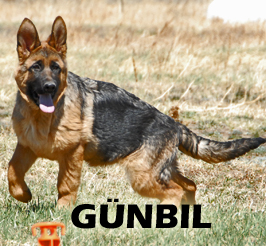
- All About German Shepherd Puppies
- Pet Disease and Allergies
- Hips and Elbows
- German Shepherd Dog Anatomy
- What is Schutzhund
- German Shepherd Behavior
- Quick Tips On German Shepherds
- Our Show Dogs
